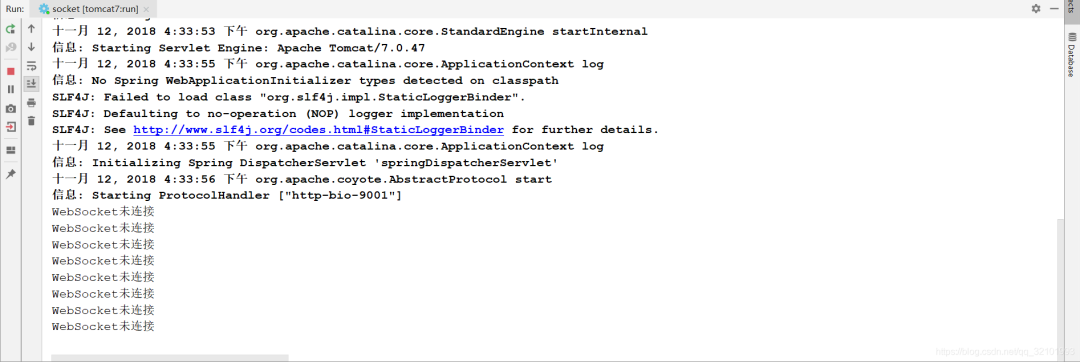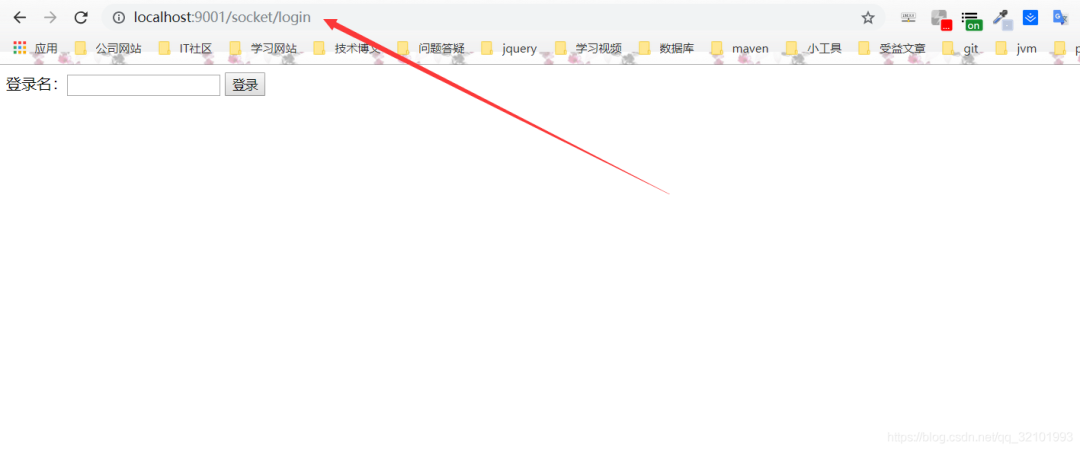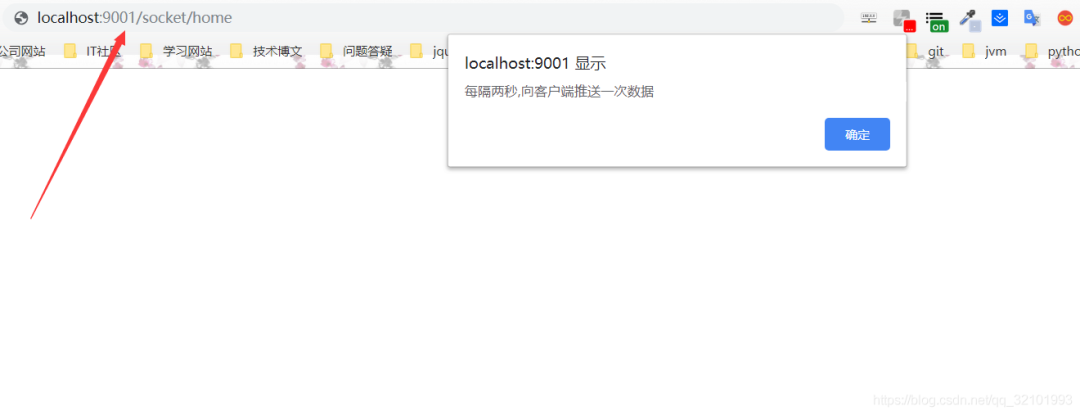Spring+websocket+quartz实现消息定时推送
websocket
简单的说,websocket是真正实现了全双工通信的服务器向客户端推的互联网技术。
全双工与单工、半双工的区别?
全双工:简单地说,就是可以同时进行信号的双向传输(A->B且B->A),是瞬时同步的。 单工、半双工:一个时间段内只有一个动作发生。
推送和拉取的区别?
推:由服务器主动发消息给客户端,就像广播。优势在于,信息的主动性和及时性。 拉:由客户端主动请求所需要的数据。
实现消息通信的几种方式?
传统的http协议实现方式:。 传统的socket技术。 websocket协议实现方式。
接下来我们主要讲第三种,使用websocket协议,来实现服务端定时向客户端推送消息。
开发环境:jdk1.8、tomcat7 后台:springmvc、websocket、quartz 前台:html5中新增的API 开发工具:IDEA、maven
实现步骤
一、环境搭建
(1)导入相关约束:
在pom文件中加入需要的约束,spring相关的约束,请各位自己导入,这里我就不贴出来了。
<dependency>
<groupId>org.quartz-schedulergroupId>
<artifactId>quartzartifactId>
<version>2.3.0version>
dependency>
<dependency>
<groupId>org.springframeworkgroupId>
<artifactId>spring-context-supportartifactId>
<version>5.1.1.RELEASEversion>
dependency>
<dependency>
<groupId>javax.websocketgroupId>
<artifactId>javax.websocket-apiartifactId>
<version>1.1version>
<scope>providedscope>
dependency>
(2)配置xml文件
web.xml中就配置前端控制器,大家自行配置。然后,加载springmvc的配置文件。
springmvc.xml文件中
<context:component-scan base-package="com.socket.web" />
<bean class="org.springframework.web.servlet.view.InternalResourceViewResolver">
<property name="prefix" value="/WEB-INF/views/"/>
<property name="suffix" value=".jsp"/>
<property name="contentType" value="text/html; charset=utf-8"/>
bean>
<mvc:annotation-driven/>
<mvc:annotation-driven>
<mvc:message-converters register-defaults="true">
<bean class="com.alibaba.fastjson.support.spring.FastJsonHttpMessageConverter">
<property name="supportedMediaTypes">
<list>
<value>text/html;charset=UTF-8value>
<value>application/jsonvalue>
list>
property>
<property name="features">
<list>
<value>WriteMapNullValuevalue>
<value>QuoteFieldNamesvalue>
list>
property>
bean>
mvc:message-converters>
mvc:annotation-driven>
到此,环境就基本搭建完成了。
二、完成后台的功能
这里我就直接贴出代码了,上面有相关的注释。
首先,完成websocket的实现类。
package com.socket.web.socket;
import org.slf4j.Logger;
import org.slf4j.LoggerFactory;
import org.springframework.stereotype.Component;
import javax.websocket.*;
import javax.websocket.server.PathParam;
import javax.websocket.server.ServerEndpoint;
import java.io.IOException;
import java.util.Map;
import java.util.Set;
import java.util.concurrent.ConcurrentHashMap;
/**
* @Author: 清风一阵吹我心
* @ProjectName: socket
* @Package: com.socket.web.socket
* @ClassName: WebSocketServer
* @Description:
* @Version: 1.0
**/
//ServerEndpoint它的功能主要是将目前的类定义成一个websocket服务器端。注解的值将被用于监听用户连接的终端访问URL地址。
@ServerEndpoint(value = "/socket/{ip}")
@Component
public class WebSocketServer {
//使用slf4j打日志
private static final Logger LOGGER = LoggerFactory.getLogger(WebSocketServer.class);
//用来记录当前在线连接数
private static int onLineCount = 0;
//用来存放每个客户端对应的WebSocketServer对象
private static ConcurrentHashMap webSocketMap = new ConcurrentHashMap();
//某个客户端的连接会话,需要通过它来给客户端发送数据
private Session session;
//客户端的ip地址
private String ip;
/**
* 连接建立成功,调用的方法,与前台页面的onOpen相对应
* @param ip ip地址
* @param session 会话
*/
@OnOpen
public void onOpen(@PathParam("ip")String ip,Session session){
//根据业务,自定义逻辑实现
this.session = session;
this.ip = ip;
webSocketMap.put(ip,this); //将当前对象放入map中
addOnLineCount(); //在线人数加一
LOGGER.info("有新的连接加入,ip:{}!当前在线人数:{}",ip,getOnLineCount());
}
/**
* 连接关闭调用的方法,与前台页面的onClose相对应
* @param ip
*/
@OnClose
public void onClose(@PathParam("ip")String ip){
webSocketMap.remove(ip); //根据ip(key)移除WebSocketServer对象
subOnLineCount();
LOGGER.info("WebSocket关闭,ip:{},当前在线人数:{}",ip,getOnLineCount());
}
/**
* 当服务器接收到客户端发送的消息时所调用的方法,与前台页面的onMessage相对应
* @param message
* @param session
*/
@OnMessage
public void onMessage(String message,Session session){
//根据业务,自定义逻辑实现
LOGGER.info("收到客户端的消息:{}",message);
}
/**
* 发生错误时调用,与前台页面的onError相对应
* @param session
* @param error
*/
@OnError
public void onError(Session session,Throwable error){
LOGGER.error("WebSocket发生错误");
error.printStackTrace();
}
/**
* 给当前用户发送消息
* @param message
*/
public void sendMessage(String message){
try{
//getBasicRemote()是同步发送消息,这里我就用这个了,推荐大家使用getAsyncRemote()异步
this.session.getBasicRemote().sendText(message);
}catch (IOException e){
e.printStackTrace();
LOGGER.info("发送数据错误:,ip:{},message:{}",ip,message);
}
}
/**
* 给所有用户发消息
* @param message
*/
public static void sendMessageAll(final String message){
//使用entrySet而不是用keySet的原因是,entrySet体现了map的映射关系,遍历获取数据更快。
Set> entries = webSocketMap.entrySet();
for (Map.Entry entry : entries) {
final WebSocketServer webSocketServer = entry.getValue();
//这里使用线程来控制消息的发送,这样效率更高。
new Thread(new Runnable() {
public void run() {
webSocketServer.sendMessage(message);
}
}).start();
}
}
/**
* 获取当前的连接数
* @return
*/
public static synchronized int getOnLineCount(){
return WebSocketServer.onLineCount;
}
/**
* 有新的用户连接时,连接数自加1
*/
public static synchronized void addOnLineCount(){
WebSocketServer.onLineCount++;
}
/**
* 断开连接时,连接数自减1
*/
public static synchronized void subOnLineCount(){
WebSocketServer.onLineCount--;
}
public Session getSession(){
return session;
}
public void setSession(Session session){
this.session = session;
}
public static ConcurrentHashMap getWebSocketMap() {
return webSocketMap;
}
public static void setWebSocketMap(ConcurrentHashMap webSocketMap) {
WebSocketServer.webSocketMap = webSocketMap;
}
}
然后写我们的定时器(quartz),这里我就不详解定时器了。大家可以自行去了解。
这里我使用的是xml注解的方式,创建一个job类,此类不需要继承任何类和实现任何接口。
package com.socket.web.quartz;
import com.socket.web.socket.WebSocketServer;
import java.io.IOException;
import java.util.Map;
import java.util.concurrent.ConcurrentHashMap;
/**
* @Author: 清风一阵吹我心
* @ProjectName: socket
* @Package: com.socket.web.quartz
* @ClassName: TestJob
* @Description:
* @Version: 1.0
**/
public class TestJob {
public void task(){
//获取WebSocketServer对象的映射。
ConcurrentHashMap map = WebSocketServer.getWebSocketMap();
if (map.size() != 0){
for (Map.Entry entry : map.entrySet()) {
WebSocketServer webSocketServer = entry.getValue();
try {
//向客户端推送消息
webSocketServer.getSession().getBasicRemote().sendText("每隔两秒,向客户端推送一次数据");
}catch (IOException e){
e.printStackTrace();
}
}
}else {
System.out.println("WebSocket未连接");
}
}
}
定时器的实现类就完成了,我们还需要在springmvc.xml中进行配置
springmvc.xml配置:
<bean id="testJob" class="com.socket.web.quartz.TestJob">bean>
<bean id="jobDetail" class="org.springframework.scheduling.quartz.MethodInvokingJobDetailFactoryBean">
<property name="targetObject" ref="testJob"/>
<property name="targetMethod" value="task">property>
<property name="concurrent" value="false" />
bean>
<bean id="trigger" class="org.springframework.scheduling.quartz.SimpleTriggerFactoryBean">
<property name="jobDetail" ref="jobDetail"/>
<property name="startDelay" value="3000"/>
<property name="repeatInterval" value="2000"/>
bean>
<bean id="scheduler" class="org.springframework.scheduling.quartz.SchedulerFactoryBean">
<property name="triggers">
<list>
<ref bean="trigger"/>
list>
property>
bean>
接下来是controller层的代码,就一个登录的功能。
package com.socket.web.controller;
import com.socket.domain.User;
import com.sun.org.apache.bcel.internal.generic.RETURN;
import org.springframework.stereotype.Controller;
import org.springframework.web.bind.annotation.RequestMapping;
import org.springframework.web.bind.annotation.RequestMethod;
import javax.servlet.http.HttpServletRequest;
import javax.servlet.http.HttpSession;
import java.util.UUID;
/**
* @Author: 清风一阵吹我心
* @ProjectName: socket
* @Package: com.socket.web
* @ClassName: ChatController
* @Description:
* @CreateDate: 2018/11/9 11:04
* @Version: 1.0
**/
@RequestMapping("socket")
@Controller
public class ChatController {
/**
* 跳转到登录页面
* @return
*/
@RequestMapping(value = "/login",method = RequestMethod.GET)
public String goLogin(){
return "login";
}
/**
* 跳转到聊天页面
* @param request
* @return
*/
@RequestMapping(value = "/home",method = RequestMethod.GET)
public String goMain(HttpServletRequest request){
HttpSession session = request.getSession();
if (null == session.getAttribute("USER_SESSION")){
return "login";
}
return "home";
}
@RequestMapping(value = "/login",method = RequestMethod.POST)
public String login(User user, HttpServletRequest request){
HttpSession session = request.getSession();
//将用户放入session
session.setAttribute("USER_SESSION",user);
return "redirect:home";
}
}
以上就是登录的代码了,基本上就是伪代码,只要输入用户名就可以了,后面的逻辑,大家可以根据自己的业务来实现。
最后就是前台页面的设计了,登录,login.jsp
<%@ page contentType="text/html;charset=UTF-8" language="java" %>
var="path" value="${pageContext.request.contextPath}"/>
登录
"${path}/socket/login" method="post">
登录名:"text" name="username"/>
"submit" value="登录"/>
消息接收页面,home.jsp
<%@ page contentType="text/html;charset=UTF-8" language="java" %>
聊天
基本上,数据推送的功能就完成了,下面附上效果图。
启动tomcat。后台定时器两秒刷新一次,判断是否有websocket连接。

登录页面:

数据推送页面:

服务器定时向客户端推送数据的功能就完成了,有不明白的可以给博主留言,如果有什么错误,也希望各位朋友指出,谢谢大家。
本文源码:
https://github.com/Qingfengchuiwoxin/websocket
来源:blog.csdn.net/qq_32101993/
article/details/83994524
评论
